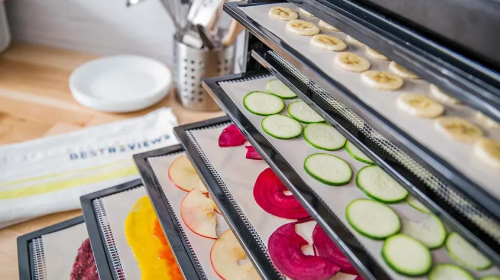What Precautions Should be Taken When Using a Freeze Dryer?
In the world of laboratory equipment, the freeze dryer reigns supreme, offering a plethora of benefits for various applications. Let's delve into the functions of a freeze dryer and the proper techniques for its optimal use.
Understanding Freeze Dryers
A freeze dryer is a sophisticated apparatus equipped with an imported compressor and a heat exchanger. These components significantly enhance its cooling capacity, leading to improved water capture capabilities. Primarily designed for laboratory use, the lab freeze dryer boasts a spacious cold trap with a sample pre-freezing function, thanks to cutting-edge technological innovations that have expanded its functionalities.
![6%KMD7]@JQ5)2I%[YYD9)`N.png 6%KMD7]@JQ5)2I%[YYD9)`N.png](https://images.techoeidm.com/upload/default/20230915/9fdf384c0fcc0def460fe4a75dd5ede4.png)
Functions of a Freeze Dryer
1. Preservation of Heat-Sensitive Substances
Freeze drying is a process conducted at low temperatures, making it particularly suitable for preserving heat-sensitive substances. Compounds such as proteins and microorganisms do not denature or lose their biological activity during this gentle drying process. This feature makes freeze dryers invaluable in the medical industry.
2. Maintaining Original Structure
One of the remarkable advantages of freeze drying is that it preserves the original structure of substances. Unlike other drying methods, freeze drying ensures minimal changes in volume and concentration, making it ideal for various laboratory applications.
3. Rapid Dissolution
The dried material produced by a freeze dryer is characterized by its loose, porous, and spongy nature. It dissolves quickly and almost immediately upon contact with water, facilitating ease of use and reconstitution.
4. Protection from Oxidation
In a vacuum environment, there is minimal oxygen present during the drying process. This characteristic safeguards easily oxidized substances, ensuring their integrity and quality.
5. Minimal Loss of Volatile Components
Drying at low temperatures in a freeze dryer results in negligible loss of volatile components in the substance. This property makes freeze drying a suitable choice for drying a wide range of products, including chemical compounds, pharmaceuticals, and food items.
6. Inhibition of Microorganisms and Enzymes
During the freeze-drying process, the growth of microorganisms and the activity of enzymes are suspended. This preservation of the original state is crucial for maintaining the quality of the product.
7. Efficient Water Removal
Drying with a freeze dryer can eliminate more than 95-99% of the water content in a substance. Consequently, dried products can be stored for extended periods without deterioration, ensuring long-term usability.
Mastering the Use of a Freeze Dryer
To harness the full potential of a freeze dryer, follow these precise steps:
Power On: Begin by switching on the "main power switch" located on the side of the chassis. Next, press and hold the "vacuum meter" button on the control panel for at least three seconds.
Activate Refrigeration: Press and hold the "Refrigeration" button on the control panel for over three seconds. The temperature digital display will indicate the actual temperature of the cold trap.
Pre-Cooling: Start the refrigerator and allow it to pre-cool for at least 30 minutes, reaching approximately -60°C.
Sample Preparation: Place your sample on the sample rack, then wipe the sealing edge and sealing strip with alcohol cotton. Cover the plexiglass cover, and press the "vacuum pump" button on the control panel for more than three seconds.
Record Values: Once the air pressure display stabilizes, diligently record the temperature and air pressure values.

Shutdown Procedure: To conclude the process, follow these steps:
Press the charging valve on the control panel and immediately turn off the vacuum pump.
When the vacuum reaches 999ka, open the plexiglass cover and retrieve your sample.
Turn off the "refrigeration" by pressing the "vacuum gauge" for more than three seconds.
Finally, switch off the main power switch.
Cleanup: After the ice in the cold trap has completely turned into water, use a dry cloth to clean the inner wall. Cover it with the plexiglass cover and a dust-proof cloth for storage.
Precautions for Optimal Usage
To ensure safety and optimal performance, adhere to these essential precautions:
1. Maximize Sample Surface Area
Expand the surface area of your prepared sample as much as possible while avoiding substances containing acid, alkali, or volatile organic solvents.
2. Ensure Complete Freezing
To prevent gasification, ensure that your sample is entirely frozen in ice. Any residual liquid can lead to undesired outcomes.
3. Mind the Cold Trap Temperature
Be cautious of the cold trap's temperature, which can reach as low as -60°C. Wear insulating gloves to protect yourself from frostbite.
4. Verify Valve and Seal Integrity
Before starting the vacuum pump, meticulously check whether the outlet valve is tightly closed, the charging valve is properly sealed, and the contact surface between the plexiglass cover and the rubber ring is clean, free of dirt, and well-sealed.
5. Usage Duration
Exercise restraint when using the lab-scale freeze dryer; continuous operation for more than 48 hours is generally discouraged.
6. Optimize Drying Time
During the freezing process, monitor the sample's temperature. After removing the sample and allowing it to warm for a period, continue drying to expedite the drying process.
In conclusion, freeze dryers are exceptional tools in laboratory settings, offering numerous benefits, including the preservation of heat-sensitive substances, maintenance of original structures, and extended product shelf life. By adhering to proper procedures and precautions, you can maximize the capabilities of this remarkable device for your laboratory needs.
- Previous: What Food Cannot Be Freeze-Dried?
- Next: When to Replace Brake Pads?

